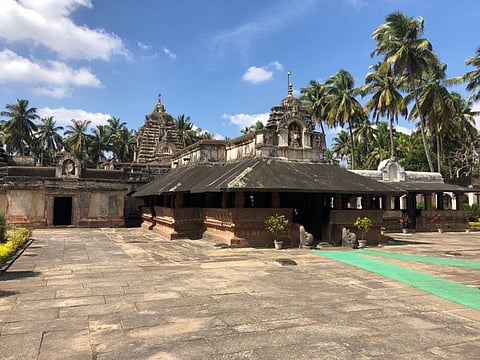India: Karnataka’s heritage temple town Banavasi stuck in time!
Quaint streets, millennium old temple offer rare opportunity to travel through time

Bengaluru: If there is any place literally stuck in time, it would be the ancient temple town of Banavasi, in the Uttara Kannada district of Karnataka.
Centred around a millennium old heritage temple, flanked by charming laterite architecture, quaint row houses and oozing a laid back atmosphere.
The town reminds us of a time less hurried and less encumbered, but more sure of itself.
Every place has its character, a certain temperament, a way of life and a mode of engagement. Every place has its soul and heart, some thriving and throbbing and some badly encumbered.
When we enter a place with a heart that is throbbing and a soul that is alive, it resonates with us and touches our inner core, making us feel at home, even though we are visiting it for the first time.
Banavasi is one such place with a resonating and appealing character. Walking through its calming streets gave us a strange sense of familiarity, as though what was unfolding before us was something that has always been within us.
Our experience with the ancient town of Banavasi was similarly magical. We felt a strange connect and familiarity with the town even though we were visiting it for the first time.
Measured, meandering and mesmerising, Banavasi follows its own rhyme and rhythm.
Hospitable people and receptive culture
Through its storied walls and reflective doors, through its hallowed pathways and nourishing paddies, through its hospitable people and receptive culture, Banavasi engages with strangers in a language of calm assurance.
Now, an unassuming small town, with characteristic nonchalance, it is hard to imagine that this was once a capital of a vast and powerful kingdom.
It was a pleasant winter afternoon, and as is customary with south Indian small towns, the streets were deserted and the doors of most of the row houses were shut, with residents indulging in the luxury of a siesta.
The only traffic on the road was of those heading to the star attraction of the town - the Madhukeshwar Temple - and that’s where we were also headed.
History is quite cruel in the way it deals with the fortunes of cities and kingdoms. The dreams that mighty empires realise into sprawling metropolises usually survive in the crumbling necropolises. What remain now are just fragments of what once were…
Looking at the tranquil surroundings of this small town near Sirsi, it is hard to imagine the pomp Banavasi exuded as a capital city of what is now the state of Karnataka, more than a millennium ago.
If not for the Madhukeshwar Temple, there is hardly anything of significance left of this small town’s glorious past.
But, the temple more or less makes up for all the heritage that has been lost to the vagaries of time. Its architecture is a kind of microcosm of the history of Karnataka, reflecting the rise and fall of several dynasties over the centuries.
Kadamba Dynasty
Whether the Kadambas, Chalukyas, Hoysalas and Sondas, each kingdom has left its mark with significant contributions to the temple complex, adding to its beauty and diversity in styles and artistry.
Dedicated to the Hindu deity Vishnu, Madhukeshwara Temple was built by Mayura Sharma of the Kadamba Dynasty in the 9th century AD. However, subsequently, the monarchs of the later dynasties such as the Chalukyas added the Sankalpa Mandapa - the central arena, while the Hoysalas built the Nritya Mandapa, an annex dedicated for folk performances.
Not to be left behind, the Sonda Dynasty also added to the diversity of the complex with several stone works and adornments.
Founded by the Kadamba Dynasty as its capital in 345AD, the region around the town of Banavasi has been continuously inhabited for more than 4,000 years. The town has been known by different names in different eras such as Vanavasika, Jayanthipura, Konkanapura, Nandanavana etc.
It was known as Jayanthipura or Vijayanthipura during the early period of the Kadamba Dynasty, while the Greek writer Ptolemy mentioned it as Banousi in his book in the first century AD.
Hiuen Tsang, the seventh century Chinese traveller and Buddhist monk visited Banavasi and mentioned the city in his famous travelogue as Konkanapura. During the time of his visit around the mid-seventh century Banavasi was a major Buddhist hub. However, like much of its past, only some vestiges of the town’s Buddhist heritage now remains.
Nevertheless, Banavasi is an important place to visit and a key landmark for those who are interested in retracing the history of South India and its development. For the lovers of architecture, Madhukeshwar Temple must be in their bucket list.
-- Shafaat Shahbandari is a freelance journalist and founder-editor of Thousand Shades of India
Sign up for the Daily Briefing
Get the latest news and updates straight to your inbox

